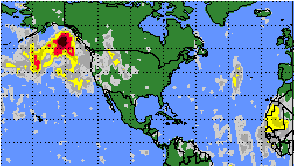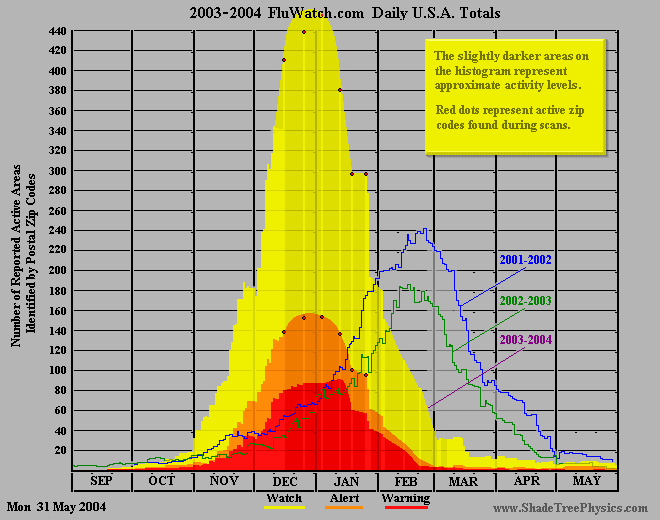The Kite-Acheson Effect
(Solar Wind Induced Electrical Lifting of Planet-Surface Particulate Matter)
A Shade Tree Physics Online PublicationInstalled 12 Nov 2003. Latest Update 30 May 2018.
Material related to the January 2004 fires in Sicily's Canneto di Caronia
has been moved to a new page.
Keywords: aerobiology, astrobiology, dust suspension, electrical lifting, solar wind
This document, or portions thereof, may be copied freely for non-profit/non-commercial purposes.
Several entries from this site's Influenza 1918, A Venus Connection? Recent Developments, Spring-Summer 2001 Part I and Part II are copied below. The two entries, dated 17 July 2001 and 1 August 2001 contain the essence of what the author calls the Kite-Acheson Effect. Each entry, prior to these two, is considered to be evidence leading to the hypothesis.
References to the on-line resource LEXIS-NEXIS® Academic Universe are indicated by the abbreviation LNAU.
3 April 2001
At 1015 Universal Time (UT) on 29 March 2001 the sun produced an intense X-class
Coronal Mass Ejection (CME) which gobbled up a lesser CME from the day before
and reached Earth at 0100 UT on 31 March. [Venus Connection?
material deleted.]
Sunday 6 May 2001
The Edmonton Sun
Calgary, Alberta - Canada
Mystery illness spreads from school children to family members. 179 students and staff
at Elizabeth Barrett elementary school in Calgary became suddenly sick on Wednesday 2 May
with vomiting, nausea and diarrhea. Lightning-fast stomach flu was believed to be blame.
City water system ruled out as source. Diarrhea generally lasts 24 hours.
(LNAU - World News - Search Term: influenza - 29 May 2002.)
8 May 2001
For about two weeks, starting on April 13, 2001 many of my co-workers and members
of their families (toddlers through adults) experienced rapidly spreading illnesses
characterized by intense stomach cramps, diarrhea and vomiting accompanied by
extreme exhaustion. Most of these people toughed it out and did not seek
medical attention. (Geographically I'm referring to the Columbus, Mississippi
area in the U.S.A.) . . .
Thursday 17 May 2001
The Pacific Dust Express - NASA
North America has been sprinkled with a dash of Asia! A dust cloud from China
crossed the Pacific Ocean recently and rained Asian dust from Alaska to Florida.

"Above: While much of the dust cloud remains over the Pacific Ocean, the leading edge has reached as far east as the American Midwest by April 13. Images such as this one are a principal tool for scientists who study aerosols." [The NASA image has been "resized" and cropped. The modified image is copied from the author's AAS poster A Search for Evidence of Interplanetary and Atmospheric Microbial Delivery Systems. [Added 13 Nov 2003.]
[April 13 was the date that the rash of "digestive system" problems began occurring near Columbus, Mississippi, U.S.A. I offer the suggestion that the settling Asian dust particles may have been responsible for the arrival of the stomach bugs, regardless of their ultimate origin. It will be interesting to find out whether or not similar illnesses began occurring geographically between the U.S. West coast and the central U.S. a day or so before April 13th.]
Thursday 14 June 2001
U. S. Geological Survey News Release
Microbes and the dust they ride in on pose potential health risks
Potentially hazardous bacteria and fungi catch a free ride across the Atlantic, courtesy of
North African dust plumes. Government researchers who made the discovery believe the
stowaway microbes might pose a health risk to people in the western Atlantic region.
Original article at www.usgs.gov/public/press/public_affairs/press_releases/pr1471m.html
is no longer available.
Tuesday 26 June 2001
NASA Science News
All the World's a Stage... for Dust
Story includes movies of an African dust cloud blowing westward to
North America in June. It also addresses questions like: Where does
topsoil for Caribbean islands come from? And, are sneezes in Florida
triggered by allergens from other continents?
Sunday 1 July 2001
Associated Press AP Online - Randolph Schmid
Africa-United States
African dust brings germs, fungi across the Atlantic
Story is based on a telephonic interview with Dale Griffin, principal investigator,
mentioned in the June 14 news release above. Readers are referred to an
article on this research in the June 2001 issue of the journal
Aerobiologia. Actually it
appeared in the September issue.(1)
(LNAU - Wires: Search Terms: bacteria, Africa)
Wednesday 4 July 2001
The Associated Press State & Local Wire
Idaho, U.S.A.
Trail volunteers stricken by mysterious disease
Sixteen out-of-state summer program volunteers at Dinosaur National
Monument were medically examined for flu-like symptoms. Eight were
hospitalized. Fungal pneumonia is suspected cause. Utah and Colorado
volunteers were not affected.
(LNAU - Wires - Search Terms: flu, dust)
16 July 2001
NASA Science News
Planet Gobbling Dust Storms
Three weeks ago a new dust storm erupted on Mars. It's the largest in 25 years and
still growing. The storm is so big that amateur astronomers using modest telescopes
can see it from Earth. [Shows movie frames of the spreading dust storm during the
period of 24 Jun to 8 July 2001.] . . . No one knows exactly how Martian dust storms
grow to such proportions.. . . [Added 13 Nov 2003. This news item was not placed
on the Global Developments pages.]
Tuesday 17 July 2001
Columbus, Mississippi
Bruce Kite, of Columbus, suggests that when thinking about desert dust storms
maybe we should consider the dielectric properties of the silicates of sand and
their interactions with terrestrial electrical charge variations brought about by solar
storms. (Electrical forces may provide a lifting mechanism involved in dust storm
generation.) He suggests that deserts may serve as reservoirs of "hibernating"
biotic forms which can activate after being transported to more habitable environments.
He posits that perhaps the dust storms that have recently kicked up on Mars may have
been triggered by (electrical) solar wind perturbations. . . .
Wednesday 1 August 2001
Page reviewer comments furnished by e-mail
Amy Acheson - Seattle, Washington
... I may have noticed it because of the coincidence that it happened the day
after I read your webpage. APOD (astronomy picture of the day) did a special
about this month's Martian dust storm, which began June 17th in the southern
hemisphere of Mars and slowly spread to all of Mars. I noticed this because in
the caption they bemoan the fact that "the timing of the storm has hidden the
Red Planet's surface from view during its period of close approach to planet
Earth." I looked up the orbits and find that Mars is currently in the "above the
ecliptic" stage of its orbit. This fits in with what I was wondering -- is the dust
storm on Mars triggered by the Earth's magnetosphere at closest approach?
[Earth was at inferior conjunction with Mars on 13 June.]
See:
APOD 2001 27 July .
Martian Dust Storm
Fast forward to 2003-2004.
* * *
The following two graphs are from this site's webpage USA Influenza Activity, 2003-2004, Part 1.


Source: ACE Science Center Cal Tech.
Note that the blast of high solar wind proton flux (which penetrated the Earth's atmosphere) began about a week before the out-of-the-ordinary influenza activity.
Possible Examples of the Kite-Acheson Effect at Work
Added 12 February 2004.
References
(1) Dale W. Griffin, Virginia H. Garrison, Jay R. Herman, Eugene A, Schinn, "African Desert Dust in the Caribbean Atmosphere: Microbiology and Public Health," Aerobiologia 17, 203-313 (2001)
Articles Related (and Possibly Related) to the Kite-Acheson Effect
[pdf] www.lpi.usra.edu/meetings/sixthmars2003/pdf/3191.pdf. These researchers present recent findings on the relation between electrical discharges in Martian dust devils and dust storms, and provide four excellent June 30, 1999 images of a Martian regional dust storm, taken by the NASA/JPL/Malin Science Systems Mars Orbital Camera. [Added 16 Nov 2003]
Ice Flash. Article deals with refrigerator ice cubes that flash in visible light when being popped out of their freezing containers. One correspondent suggests that pizeoluminiscence is involved. Another suggests a form of triboluminescence. The process (whatever it is) which causes the ice cubes to flash might also produce electrical discharges between the cubes and their very-recently former containers. If volcanic ash is crystaline, then grinding it underfoot may produce electrical discharges. Article has links to related websites. [Added 22 Feb 2004.]
C.E. Krauss, M. Horányi and S. Robertson, "Experimental Evidence for electrostatic discharging of dust near the surface of Mars," New Journal of Physics, 5 (2003) 70.1-70.9. Laboratory experiments have shown that single non-conductive dust grains can attain large electric potentials due to triboelectric charging. Online Copy: (HTML). [Added 1 March 2004.]
Low cloud properties influenced by cosmic rays - Nigel D. Marsh and Henrik Svensmark - Danish Space Research Institute, Copenhagen, Denmark. - Phys Rev Lett. 2000 Dec 4;85(23):5004-7 - arXiv:physics/0005072 v2 27 Nov 2000 -"The influence of solar variablity on climate is currently uncertain. Recent observations have indicated a possible mechanism via the influence of solar modulated cosmic rays on global cloud cover. Surprisingly the influence of solar variablity is strongest in low clouds (<=3km), which points to a microphysical mechanism involving aerosol formation that is enhanced by ionization due to cosmic rays. If confirmed it suggest that the average state of the Heliosphere is important for climate on Earth." [Added 05 Dec 2004.]
Update: Low Cloud Properties Influenced by Cosmic Rays - Nigel Marsh and Henrik Svensmark, Danish Space Research Institute, Copenhagen, Denmark - 6th December 2001 (latest revision 7/12.01) - [Added 05 Dec 2004.]
Original link at www.dsri.dk/~ndm/CLOUD_UPDATE/UPDATE.html doesn't work now.